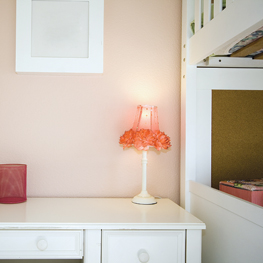
When we purchased our first home, friends commented on its small size. “We don’t intend to stay forever,” my husband replied. “In three years, we’ll sell and move up.”
Three years came and went and we still lived in our little cottage. We never intended to stay for nine years, and we certainly never meant to live in 600 square feet with four children, but we did.
Living in a small space with children, and keeping your sanity, requires organization. Besides the old maxim: “A place for everything and everything in its place,” let me share with you the top three ways that I made that happen.
1. Discourage collections – When small, my kids each had one good-sized plastic bin with a lid for their special things. These bins were just the right size to slide under the bunk beds. Anything a child wanted to save (school papers, rocks, crafts, etc.) had to fit in his special box. If he wanted to save something that would not fit, he knew the rule: something must go to make room for it. This system not only kept their 100-square-foot bedroom with two sets of bunk beds neat and tidy, but discouraged them from turning into packrats later in life.
The Mast family has four boys in a single-wide trailer. Mom, Kathy, says, “One thing that is a constant battle is watching what comes into the house.” The boys share one room and, in addition to those under-the-bed tubs, each has his own headboard shelves for special items.
2. Create storage space – Thankfully, we had a single car garage for storage; and I learned to use it. But sometimes it just wasn’t enough. When those walls seem a little closer than you would like, it’s time to create space. Here are a few tricks to keep up your sleeve:
Use a trunk as a coffee table. Store your linens or board games in it. Mast keeps a small dresser in her living room. On the top are plants and pictures. In the drawers are school items, CDs and other miscellaneous things. Another mom, Terie, uses night stands as living room end tables for the drawer space.
Install shelving to hold bins for children’s clothing and toys. This saves floor space and, if the shelves are high enough, keeps the toddlers from dumping everything on the floor. Trina, mother of three, covers cardboard boxes with leftover fabrics. Similar decorated boxes cost $15 to $20 at the local superstore.
Trina also stores her daughter’s balled-up sock pairs in a gallon pickle jar on top of the dresser. Besides freeing up drawer space, it “makes a nice piece of modern art.”
Purchase or make under-the-bed drawers. Platform beds with drawers underneath are a great way to make use of otherwise unused space. If you cannot afford to purchase new furniture, you can get plastic storage containers on wheels for this very purpose. To double this unused space, another mom purchased a set of bed raisers to elevate the bed another 6 inches.
If you have space above your kitchen cupboards, store seldom used things up there. String a curtain in front to hide them from view.
3. Have a system – I implemented a filing system that made storing, and finding, a breeze. You will need:
• Boxes
• 3 X 5 file box
• 3 X 5 cards
• Permanent markers
You want to choose sturdy boxes with lids. The kind copy paper comes in is great. Or, if it’s within your budget, invest in plastic ones. Mast says, “Plastic storage boxes are a must for storing in a shed, to keep mice out.” Whatever you do, shy away from any cartons that food came in (like banana boxes). They will attract (or may even introduce) unwanted pests.
Pack similar things together in your boxes. When a box is full, list the contents on a 3 X 5 card. In the top left-hand corner of the card, write a letter. The first card you make will be A, the second B and so forth. Write the corresponding letter on all sides of the box so that if your boxes get turned around, you can still see the label.
Next, on the top right-hand corner of the card, write where you stored the box. Store the cards in the plastic file box in alphabetical order. When you want that purple polka-dotted diaper bag out of storage, simply thumb through the card file until you find it listed, note the box and location, and go get it.
If you have quite a few things to store away, you may want to color code the cards. For example, use yellow cards for household items, pink cards for books, green cards for baby clothes and blue cards for toys. If you want your boy’s Matchbox car collection, you know to only thumb through the blue cards. If you choose to color code the cards, color code the boxes by using colored markers to write on the letters. That way, you may have four boxes with A’s on them – one yellow, one blue and so forth. If you cannot find cards in enough different colors, running a marker along the top edge of the card works just as well. That way, you have as many different colors as you have markers.
Besides implementing these strategies, what is the key to overcoming the frustrations that living in a small space can bring? “Work on maintaining a spirit of joy and gratefulness,” shares Mast, “and avoid comparing your situation with others!”
A freelance writer, Carol lives in a much larger house now; but with four of their six kids currently at home, she still needs to implement some of these strategies.
Calgary’s Child Magazine © 2024 Calgary’s Child